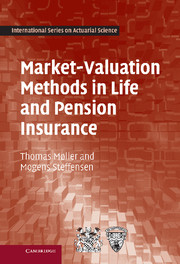Book contents
- Frontmatter
- Contents
- Preface
- 1 Introduction and life insurance practice
- 2 Technical reserves and market values
- 3 Interest rate theory in insurance
- 4 Bonus, binomial and Black–Scholes
- 5 Integrated actuarial and financial valuation
- 6 Surplus-linked life insurance
- 7 Interest rate derivatives in insurance
- Appendix
- References
- Index
4 - Bonus, binomial and Black–Scholes
Published online by Cambridge University Press: 13 August 2009
- Frontmatter
- Contents
- Preface
- 1 Introduction and life insurance practice
- 2 Technical reserves and market values
- 3 Interest rate theory in insurance
- 4 Bonus, binomial and Black–Scholes
- 5 Integrated actuarial and financial valuation
- 6 Surplus-linked life insurance
- 7 Interest rate derivatives in insurance
- Appendix
- References
- Index
Summary
Introduction
In Chapter 2 we discussed some aspects of valuation assuming only one possible investment with a deterministic interest rate. In Chapter 3 we introduced a stochastic interest rate and a bond market and we discussed the consequences for valuation in general and for valuation of guaranteed payments in particular. In this chapter we again assume a deterministic interest rate, but, in return, we introduce the possibility of investing in stocks and study the total reserve including the reserve for guaranteed payments. In Section 4.6 we comment on the combination of stochastic interest rates and investment in stocks.
The total reserve in connection with a life insurance contract can, under certain conditions, be calculated using a simple retrospective accumulation. The condition is that the total reserve which has been accumulated at the termination of the contract equals the pension sum paid out. We consider the type of insurance where the surplus is accumulated in the technical reserve leading to an increasing pension sum. Here, the condition is that the undistributed reserve, which is the total reserve minus the technical reserve, at the termination of the contract equals zero. The condition and its consequences are formalized and studied in Chapter 2.
One very simple situation in Chapter 2 was the financial market, which consists of one investment possibility only, namely the possibility of investing in the risk-free interest rate. Furthermore, this risk-free interest rate is assumed to be deterministic.
- Type
- Chapter
- Information
- Market-Valuation Methods in Life and Pension Insurance , pp. 101 - 145Publisher: Cambridge University PressPrint publication year: 2007

